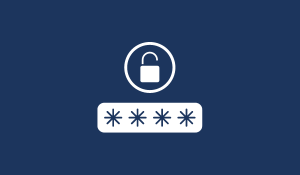Secure passwords 101: 14 tips and tricks for robust protection
Digital life is now inseparable from daily life. We manage our finances, communicate with loved ones, and store sensitive information all online. But...
6 min read
 DriveLock
Aug 7, 2025 10:15:00 AM
DriveLock
Aug 7, 2025 10:15:00 AM

The IT security landscape is constantly evolving, and with it the methods of authentication. One of the most promising developments is passwordless authentication. It promises not only greater security, but also improved user-friendliness. But what is behind it, and what advantages does it offer specifically for organizations in healthcare, industry and critical infrastructures?
| CONTENT |
Passwordless authentication promises not only a significant increase in security, but also a noticeable improvement in user-friendliness. But what technologies are behind it and how can passwordless authentication be successfully integrated into existing systems?
Passwordless authentication eliminates the need to remember or manage passwords. Instead, modern alternatives such as biometric features (fingerprint, facial recognition), hardware tokens or cryptographic keys are used. These methods are not only more secure, but also more user-friendly and reduce the risk of phishing attacks.
In 2025, we see passwordless authentication becoming a key cybersecurity trend, especially in sensitive areas such as healthcare, industry and critical infrastructure in Germany and Austria. The advantages are obvious:
Increased security:
Biometric data is unique and difficult to forge.
Hardware tokens and cryptographic keys provide additional layers of security.
Vulnerability to phishing attacks is greatly reduced.
Improved user experience:
No more complex passwords that need to be changed regularly.
Faster and easier access to systems and applications.
Compliance:
Many industry regulations and data protection laws (such as the GDPR) require strong authentication methods.
Passwordless authentication can help meet these requirements.
For IT security specialists in critical sectors, this means that they should familiarise themselves with these technologies at an early stage to ensure the security of their systems and data.
Implementing passwordless authentication is an important step towards countering growing cyber threats and strengthening your organisation's resilience.
Passwords have been the standard means of authentication for decades - and at the same time one of the biggest weaknesses in IT security. Phishing attacks, data leaks and human error make it clear that traditional passwords are simply no longer sufficient to protect sensitive data. Despite strict policies and complex requirements, passwords are often reused, poorly managed or compromised by phishing and brute force attacks.
A major problem is that strong passwords are reused too often (a risk a password manager helps mitigate but doesn't eliminate), managed insecurely or compromised by sophisticated attacks such as phishing and brute force. Even an inherently secure password can become a threat if it falls into the wrong hands or is used across multiple services.
In security-critical areas such as healthcare, industry or public administration, this can have serious consequences. Traditional passwords are vulnerable to a variety of attacks, including
Phishing: users are tricked into entering their credentials on fake websites
Credential stuffing: Attackers use stolen passwords to log into different accounts.
Brute force attacks: Automated tools test thousands of passwords until the correct one is found.
Passwordless authentication eliminates these risks, as there are no passwords that can be stolen or guessed. This offers a decisive advantage, especially in critical sectors with high security requirements.
Passwordless authentication can be implemented in various ways, depending on the security requirements and technical environment. It offers a variety of approaches to increase security and improve usability at the same time.
While some methods are based on biometric features, others use physical security keys or cryptographic methods to reliably confirm identities. Below we present four proven methods that provide a robust and secure alternative to traditional passwords.
Biometric methods: Biometric authentication uses unique physical characteristics to identify the user beyond doubt. Fingerprint scanners, facial recognition or iris scanning are now widely used and offer a high level of user-friendliness. Modern devices store biometric data locally and use secure hardware modules (e.g. Trusted Platform Modules, TPM) to prevent tampering. A major advantage: biometric features cannot be forgotten or passed on - however, data protection and counterfeit protection must always be taken into account.
Hardware tokens: Security keys such as YubiKey or smartcards are based on physical authentication and significantly increase security. These devices generate or store cryptographic keys that can only be used in combination with authorized hardware. They are a proven method of securing access, particularly in highly sensitive environments such as hospitals or industrial control systems. As the key must be physically present, classic remote phishing attacks are ineffective - but their use requires well thought-out key management.
One-time codes and push notifications: Here, the user receives a confirmation request on their mobile device, which they must actively approve. This method is often implemented via authentication apps or SMS codes and is particularly user-friendly. As the code or push notification is only valid for a limited time, the risk of replay attacks is minimized. However, it is important that the mobile device itself is well protected, for example by encryption or additional PIN protection.
Public key cryptography: This method is based on asymmetric key pairs in which a private key is securely stored on the user's device and a public key is used for authentication. FIDO2 and WebAuthn standards rely on this principle to enable secure, passwordless login to corporate networks and online services. As the private key never leaves the system, attacks by keyloggers or phishing are ineffective. Public key cryptography therefore offers a high level of security - but requires an appropriate infrastructure for key generation and management.
Passwordless authentication is not just a trend, but an essential security measure for organizations that need to protect sensitive data and critical infrastructures. In Germany and Austria, where data protection and IT security are top priorities, passwordless authentication offers significant advantages in specific sectors such as healthcare, industry and critical infrastructures. Let's take a look at how this technology can improve security and efficiency in these areas.
Passwordless authentication not only provides increased security in these critical areas, but also improved usability and efficiency. By implementing this technology, organizations can better protect their systems and data while streamlining their operations.
While the introduction of passwordless authentication promises significant improvements in security and ease of use, it also presents unique challenges, particularly in sensitive areas such as healthcare, manufacturing and critical infrastructure. It's important to understand these challenges to ensure a successful implementation. Let's take a look at the specific hurdles that can arise in these areas.
Critical infrastructure: Critical infrastructure such as energy supply, transport and telecommunications are vulnerable to cyber attacks that can have serious consequences. Passwordless authentication, especially in combination with multi-factor authentication, provides an additional layer of security to protect access to these important systems. For example, push notifications and one-time codes can secure remote access to control systems, minimising the risk of cyber attacks.
Industry: In the manufacturing industry, especially in Industry 4.0, the security of production facilities and intellectual property is crucial. Hardware tokens and public key cryptography can secure access to critical systems and equipment, reducing the risk of industrial espionage and sabotage. For example, smart cards can control access to production lines and sensitive research and development areas, ensuring the integrity of production processes.
Healthcare: In healthcare, the protection of patient data is of paramount importance. Passwordless authentication, especially through biometric methods, enables secure and fast access to electronic patient records. This minimises the risk of data leaks and unauthorised access while optimising the workflow for medical staff. For example, facial recognition can ensure fast and secure access to patient data in emergency situations where every second counts.
Passwordless authentication removes the weakest link in the security chain—the password. Methods like biometrics (fingerprint, facial recognition) are unique and difficult to forge. Hardware tokens and cryptographic keys are much harder to compromise than a password, making attacks like phishing and credential stuffing ineffective.
Users no longer have to remember complex passwords or reset them frequently. This allows for faster and more seamless access to systems, which is especially important for critical sectors where quick access to information, like patient data, is essential.
Traditional passwords are a primary target for cyberattacks. They are vulnerable to phishing, brute force attacks, and credential stuffing. Since passwordless authentication eliminates the password, it directly counters these threats, making systems more resilient against common hacking techniques.
The technology offers various methods to suit different security needs. These include biometric methods for high convenience, hardware tokens for strong physical security, one-time codes and push notifications for user-friendly multi-factor authentication, and public key cryptography for robust, secure logins.
Implementing a passwordless authentication system requires careful planning, but it's a worthwhile investment. It not only helps organizations comply with strict data protection regulations but also significantly strengthens their resilience against growing cyber threats, protecting sensitive data and critical infrastructure for the long term.
Overcoming these challenges requires careful planning, thorough risk assessment and close collaboration between IT security specialists, users and vendors. It is important to consider the specific requirements of each area and develop a customized solution that is both secure and user-friendly.
Passwordless authentication is a future-proof alternative to traditional passwords and offers significant security benefits, particularly for companies in the healthcare, industrial and critical infrastructure sectors. While implementation requires strategic planning, the long-term benefits in terms of security and ease of use clearly outweigh the risks. If you want to take your IT security to the next level, now is the time to look into passwordless solutions.

Digital life is now inseparable from daily life. We manage our finances, communicate with loved ones, and store sensitive information all online. But...

1 min read
National Security authorities recommend hard disk encryption as an effective measure for protecting data on desktop clients and notebooks in a...

Security Awareness Programs: IT Security Starts with the Users." we discussed that the users need to feel involved with the awareness programs in...